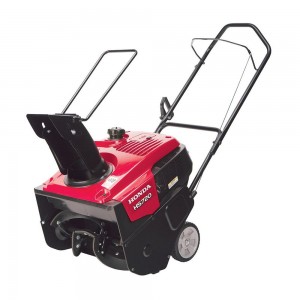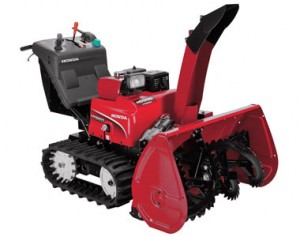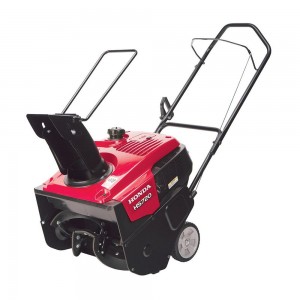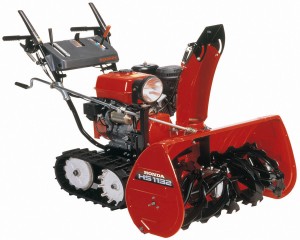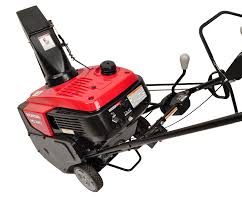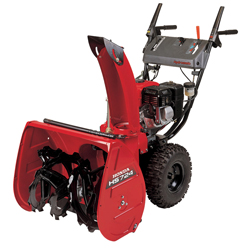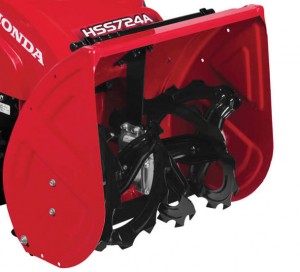 Want to make sure your light-duty Honda snow blower maintains its performance? Here’s what you need to know to keep your HSS724AT, ATD, AW or AWD two-stage snow blower working reliably.
Want to make sure your light-duty Honda snow blower maintains its performance? Here’s what you need to know to keep your HSS724AT, ATD, AW or AWD two-stage snow blower working reliably.
Maintenance Schedule
Before use: Check engine oil level, skid shoes, scraper, tire pressure, shear bolts, and bolts and nuts.
Before the start of the season: Change the oil. Check the tracks (if equipped) and charge the battery (if equipped.)
Before storage: Lubricate joints and chains, drain fuel system and charge battery.
First month or 20 hours of use: Change engine oil. Check tracks (if equipped,) belts and cables.
Every 100 hours: Change oil and clean spark arrester.
Every four years or 300 hours: Replace spark plug.
Honda recommends having these snow blowers professionally serviced before the start of the season for cable and belt adjustment, every 300 hours for engine maintenance, every two years for fuel system cleaning, and every 1,000 hours for combustion chamber cleaning.
Fuel
To drain the fuel system, remove the sediment cup on the bottom of the carburetor and turn on the fuel valve. Once drained, replace the cup and run the engine until it stalls.
Oil
When checking the oil, do not screw the dipstick into the filler neck.
The engine has an extension on the drain plug to allow oil to drain outside of the snowblower frame. When draining the crankcase, use a 17 mm wrench to keep the extension from spinning and a 10 mm to unscrew the drain bolt. Always use a new washer when reinstalling the drain bolt. Torque the drain bolt to 8.1 ft-lbs. to get a tight seal.
This engine holds 0.6 quarts of 5w20 oil. When filled, the oil level should come up to the bottom edge of the filler neck opening.
Spark Plug
The spark plug is above the cylinder head, just to the right of the muffler. Wait 20-30 minutes after running the engine before checking the plug to prevent burns from the exhaust.
The spark plug gap should be between 0.028 to 0.031 inches. When installing the plug, torque it to 13 ft-lbs.
Tracks
With 11 lb-ft. of pressure on the top center of the tread, the tread should deflect 7/16 to 5/8 inches. Tension is controlled by tensioner bolts on the rear axle. To change the tension, loosen the outer lock nut, then turn the inner tension nut. Once the tension is correct, torque the lock nut to 16 ft-lbs.
Tires
On wheeled models, the tires should be aired up to 20 PSI. When checking the tire pressure, be sure to check the tire surface for signs of damage and dry rot, replacing as needed.
Shear Bolts
Shear bolts are designed to snap if the auger or impeller is jammed, cutting power transfer. Always use genuine Honda shear bolts to ensure they break away before your machine is damaged.
If a bolt breaks, shut off the engine and wait until everything on the snow blower has come to a complete stop before walking to the auger.
Inspect the auger housing for debris build-up or other issues that may have caused the break. Once the problem has been addressed, the broken bolts can be replaced. HSS724 snow blowers use two types of shear bolts:
The carriage shear bolt is for the impeller. It goes into a hole directly behind the transmission.
The auger connects to the transmission using a pair of standard shear bolts. These go in holes next to the transmission. All shear bolts thread into 6 mm self-locking nuts.
Skid Shoes and Scraper
Shoe wear: If the edge of the shoe is less than 0.02 inches thick, flip the shoe upside down to use the other edge. If both edges are worn, replace the shoe.
Shoe and scraper adjustment: If your model has track drive, push auger height adjustment lever and push on handlebars to raise to max position. Release pressure on the bars and let the auger slowly lower until the skid shoes contact ground.
Loosen bolts and adjust the height to meet snow conditions:
Normal clearing conditions – 5/32-5/16 inches
Ice-covered surfaces – 0-3/16 inches
Rough, uneven surfaces – 1-1 3/16 inch
Scraper ground clearance should be 3/32 to 5/32 inch under all operating conditions.
Torque scraper bolts to 18.5 lb-ft. and skid shoe nuts to 19.5 lb-ft.
Battery
Electric start models have a battery inside a housing next to the handles. Check the voltage every 6 months. If the output is under 12.9 volts, it needs to be recharged at 1.2 amps for 5-10 hours.
Get the Quality OEM Parts You Need for Your Snow Blower
Hondalawnparts.com is an authorized Honda Engines and Honda Power Equipment dealer. That means we’re able to ship OEM parts and accessories for your snow blower and its engine to any location in the U.S. or Canada. Our site has a section for commonly needed snowblower parts including belts and shear pins, or you can use our search engine to find parts specific to your model.

